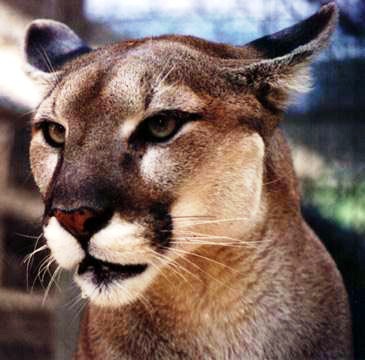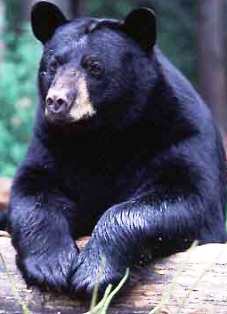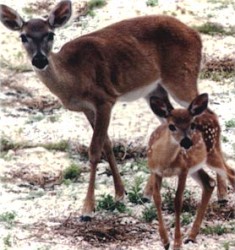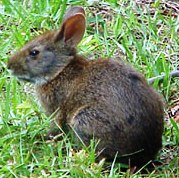Discover Florida Nature
It's time to explore the natural Florida


|
|
|
|
|
 Florida
Panther (Puma concolor coryi) Endangered- The Florida panther,
Florida’s state animal, is one of the most endangered mammals on earth!
Also called puma, cougar and mountain lion, the Florida panther is a
large slender cat, tawny on top with a whitish underside. The Male
Florida panther averages 119 pounds and the female weighs around 82
pounds. Rather than the tawny appearance of some other cougars, the
Florida panther's rufus pelage is highlighted with gray on the face,
fore paws and elsewhere. Sadly, the number of Florida panthers remaining
in the wild dwindled to somewhere between 30 and 50. Panther habitat
includes swamps and marshes. Panthers eat mostly white- tailed deer,
feral pigs, armadillos, and raccoons. They are solitary and territorial
animals that travel hundreds of miles within their home range. Panthers
are mostly active between dusk and dawn, and rest during the heat of the
day. Males have a home range of 200 square miles and females about 75
square miles. Panthers are usually quiet, but they do communicate
through vocalizations. Sounds they make have been described as chirps,
peeps, whistles, purrs, moans, screams, growls, and hisses. Females
signal their readiness to mate by yowling or caterwauling. Florida
Panther (Puma concolor coryi) Endangered- The Florida panther,
Florida’s state animal, is one of the most endangered mammals on earth!
Also called puma, cougar and mountain lion, the Florida panther is a
large slender cat, tawny on top with a whitish underside. The Male
Florida panther averages 119 pounds and the female weighs around 82
pounds. Rather than the tawny appearance of some other cougars, the
Florida panther's rufus pelage is highlighted with gray on the face,
fore paws and elsewhere. Sadly, the number of Florida panthers remaining
in the wild dwindled to somewhere between 30 and 50. Panther habitat
includes swamps and marshes. Panthers eat mostly white- tailed deer,
feral pigs, armadillos, and raccoons. They are solitary and territorial
animals that travel hundreds of miles within their home range. Panthers
are mostly active between dusk and dawn, and rest during the heat of the
day. Males have a home range of 200 square miles and females about 75
square miles. Panthers are usually quiet, but they do communicate
through vocalizations. Sounds they make have been described as chirps,
peeps, whistles, purrs, moans, screams, growls, and hisses. Females
signal their readiness to mate by yowling or caterwauling. Florida
Black Bear
(Ursus americanus floridanus) Threatened- The Florida black bear is the
largest land mammal in Florida. A small population of the Florida black
bear roams in the Chassahowitzka Swamp and the adjacent coastal wildlife
refuge areas in Pasco, Hernando and Citrus counties. Larger populations
occur in the Ocala National Forest, the Big Cypress Swamp and other
protected wilderness regions across the state. Most likely between 1,000
and 1,500 bears live in Florida. Like all members of the bear family,
black bears are large, powerful mammals with rounded ears, short tails,
5-toed feet, and large canine teeth. Adult males in Florida normally
weigh between 250 - 450 pounds, and adult females in Florida normally
weigh between 125 - 250 pounds. All black bears in the Southeast,
including Florida black bears, are black. The muzzle may be tan or
nearly black, and blonde or white chest blazes of all shapes and sizes
are common. Black bears eat mainly acorns, nuts, berries, and other
vegetation as well as insects. A small percentage of their diet is meat
which is mostly obtained from scavenging. Florida
Black Bear
(Ursus americanus floridanus) Threatened- The Florida black bear is the
largest land mammal in Florida. A small population of the Florida black
bear roams in the Chassahowitzka Swamp and the adjacent coastal wildlife
refuge areas in Pasco, Hernando and Citrus counties. Larger populations
occur in the Ocala National Forest, the Big Cypress Swamp and other
protected wilderness regions across the state. Most likely between 1,000
and 1,500 bears live in Florida. Like all members of the bear family,
black bears are large, powerful mammals with rounded ears, short tails,
5-toed feet, and large canine teeth. Adult males in Florida normally
weigh between 250 - 450 pounds, and adult females in Florida normally
weigh between 125 - 250 pounds. All black bears in the Southeast,
including Florida black bears, are black. The muzzle may be tan or
nearly black, and blonde or white chest blazes of all shapes and sizes
are common. Black bears eat mainly acorns, nuts, berries, and other
vegetation as well as insects. A small percentage of their diet is meat
which is mostly obtained from scavenging.  Key
Deer
(Odocoileus virginianus clavium) Endangered- The key deer is
the smallest in the North American deer species. Adults can measure up
to 30 inches at the shoulder. Males can weight up to 75 pounds and
females can weight up to 65 pounds. These deer inhabit Big Pine Key and
various surrounding keys. They are not found anywhere else in the
world. The key deer is a vegetarian. Key deer feed on native plants such
as red, black and white mangroves, thatch palm berries and over 150
other species of plants. Key deer can tolerate small amounts of salt in
their water and they will also drink brackish water, but fresh water is
essential for their survival. Due to uncontrolled hunting and habitat
destruction, their numbers were estimated less than 50 animals in
1940's. With the establishment of National Key Deer Refuge in 1957 and
intensive law enforcement efforts, the population has since increased
and has now stabilized. The estimated population is approximately 600
deer on Big Pine Key and No Name Key Key
Deer
(Odocoileus virginianus clavium) Endangered- The key deer is
the smallest in the North American deer species. Adults can measure up
to 30 inches at the shoulder. Males can weight up to 75 pounds and
females can weight up to 65 pounds. These deer inhabit Big Pine Key and
various surrounding keys. They are not found anywhere else in the
world. The key deer is a vegetarian. Key deer feed on native plants such
as red, black and white mangroves, thatch palm berries and over 150
other species of plants. Key deer can tolerate small amounts of salt in
their water and they will also drink brackish water, but fresh water is
essential for their survival. Due to uncontrolled hunting and habitat
destruction, their numbers were estimated less than 50 animals in
1940's. With the establishment of National Key Deer Refuge in 1957 and
intensive law enforcement efforts, the population has since increased
and has now stabilized. The estimated population is approximately 600
deer on Big Pine Key and No Name Key Lower
Keys Marsh Rabbit
(Sylvilagus palustris hefneri) Endangered- The lower keys marsh
rabbit is a small rabbit, averaging 14-16 inches in length. It has dark
brown dorsal fir and a grayish underside. The ears of the lower keys
marsh rabbit are relatively small for a rabbit, only 1.75 -1.92 inches.
Unlike the cottontail rabbit, this rabbit's tail is inconspicuous, a
dark brown above and gray underneath. The subspecies lower keys marsh
rabbit is endangered and its range is limited to the lower Florida Keys. Lower
Keys Marsh Rabbit
(Sylvilagus palustris hefneri) Endangered- The lower keys marsh
rabbit is a small rabbit, averaging 14-16 inches in length. It has dark
brown dorsal fir and a grayish underside. The ears of the lower keys
marsh rabbit are relatively small for a rabbit, only 1.75 -1.92 inches.
Unlike the cottontail rabbit, this rabbit's tail is inconspicuous, a
dark brown above and gray underneath. The subspecies lower keys marsh
rabbit is endangered and its range is limited to the lower Florida Keys.
|
|
|
Advertise | Privacy Statement | Dog Encyclopedia | Video |Contact | Alaska Nature |
|